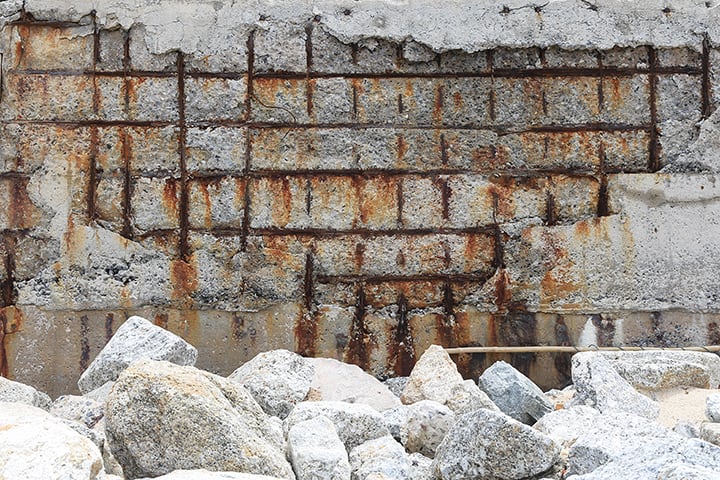by the Curtin Corrosion Centre
Corrosion-related damage to infrastructure in Australia continues to be a growing concern for the construction industry and is estimated to cost a staggering $8 billion each year.
30 billion tonnes of concrete are used for construction each year and concrete continues to be the most widely used material in the industry, being used twice as often as all other industrial materials such as wood, steel, plastic, and aluminium combined, due to its low cost, versatility, and durability.
Reinforced concrete has been used with outstanding success in a wide variety of civil infrastructures, such as tunnels, bridges, marine structures, and sewer systems. Marine structures, such as jetties and ports, are commonly built with reinforced concrete and are most at risk as they corrode due to their exposure to harsh conditions, such as salt water.
The durability and lifespan of these structures is affected by the frequent exposure to aggressive environments which speed up the deterioration processes. This predominantly occurs due to the combined degradation of concrete and corrosion of steel reinforcement.
These structures are critical to the marine and transport industries which rely on these types of structures for their daily operations. If they become corroded, it can lead to loss of functionality, high maintenance costs, disruption to offshore operations, and in rare extreme situations, catastrophic failures causing injuries.
Being able to forecast the long-term durability performance of reinforced concrete structures in their actual environments is crucial for maintenance planning of existing structures, and for designing durable and sustainable new structures.
What is the solution?
Despite decades of research, the underlying mechanisms behind steel reinforcement corrosion and structural damage in marine environments remain elusive. The team at the Curtin Corrosion Centre, with funding support from SmartCrete CRC, is setting out to find an innovative solution to tackle this growing problem.
Research has commenced in the development of an artificial intelligence (AI)-supported corrosion monitoring tool to improve the maintenance of marine structures impacted by corrosion and to look at better ways to repair ageing marine structures built with commonly used engineering materials such as reinforced concrete.
A combination of asset history and novel wireless sensors will also be used. The new AI-based decision-making tool will be fed data on the marine structures and the Machine Learning (ML) algorithms will produce reports of high-risk areas for the port authorities, so the maintenance strategies can be scheduled.
Based on the identified high-risk areas, suitable monitoring sensors will be installed. Investigation into better repair solutions to lengthen the life and extend the inspection interval for these structures will also be undertaken.
Development of new wireless sensors based on long-range communication technology forms part of the research project, as does establishment of new test protocols to assess the chloride-induced corrosion resistance of new and sustainable construction materials, new coatings and sealants and new corrosion inhibitors.
Corrosion affects us in more ways than we realise. The use of metals in the construction industry is high and these types of materials commonly corrode due to their exposure conditions.
Depending on where this metal is used, the extent of corrosion can range from damage to infrastructure, contamination of drinking water, shortage of gas supply, and major environmental damage.
Currently, there is limited knowledge surrounding the corrosion of existing reinforced concrete structures and this may lead to conservative decisions and early repair or rehabilitation prior to the useful service life.
The future of corrosion management
A further challenge that both engineers and researchers will continue to face is the need to constantly assess the suitability of innovative and sustainable construction materials to meet the increasingly demanding durability requirements.
Corrosion monitoring techniques that enable early detection of corrosion are imperative to reduce the risk of structural disintegration. However, traditional corrosion monitoring techniques are typically expensive and labour intensive.
Conventional methods for measuring the chloride profile of reinforced concrete involve chemical or physical laboratory techniques, which extract samples from in-service structures. These methods are often destructive and incur high direct and indirect costs.
For example, traditional in-service inspection and maintenance programs of highway structures cause traffic delay, which accounts for 15 to 40 per cent of the construction costs. Therefore, development of automated corrosion monitoring techniques based on sensors has gained increasing attention worldwide.
The Curtin Corrosion Centre at Curtin University, is committed to leading research in this space and collaborating with industry to ensure this level of corrosion is managed more appropriately.
Considering the multifactorial nature of concrete corrosion, using new, developing technologies such as artificial intelligence is the way forward. These technologies are highly efficient for research and can play a key role in the construction industry.
Not only does AI help with improving the way corrosion is monitored daily, but it also reduces the amount of time spent by contractors assessing corrosion in person, which significantly reduces maintenance costs.
For more information, visit https://curtin-corrosion-centre.com, or email [email protected].


